Scientists in Canada have developed a simple chemical detector that could be used to detect airborne neurotoxic organophosphorus chemical warfare agents.
Exposure to organophosphorus agents blocks the action of cholinesterase enzymes, which causes the neurotransmitter acetylcholine to accumulate in the brain. This rapid reaction causes bronchoconstriction (constriction in the airways in the lungs, owing to a tightening of surrounding smooth muscle), seizures, and finally death. Some agents, such as sarin and soman, are odourless and colourless, which makes them difficult to detect. Current detection methods require specialist equipment and trained personnel, so are of limited use in the field.
The photoresponsive dithienylethene changes colour in the presence of an organophosphorus agent
Neil Branda at Simon Fraser University, Burnaby, and colleagues, have designed a chemical detector made of a dithienylethene compound that binds with organophosphorus agents in the same way that the agents bind to enzymes in the body. When the detector is bound to an agent, its structure alters, causing it to change from colourless to blue when exposed to UV light. This simple colour change provides a clear signal. Visible light resets the system by triggering the reverse reaction.
Read the full story in Chemistry World and download the ChemComm article to find out more about Branda’s research.











